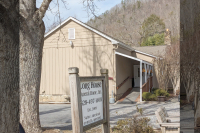Forests for the future: First glimmers of forest plan draw polarized reactions
 When Brent Martin emerged from the Forest Management Plan meeting in Franklin, the first glimpse into the direction that management in the Pisgah and Nantahala national forests might take over the next few decades, he was upset. Shocked. Disbelieving, even.
When Brent Martin emerged from the Forest Management Plan meeting in Franklin, the first glimpse into the direction that management in the Pisgah and Nantahala national forests might take over the next few decades, he was upset. Shocked. Disbelieving, even.
“I would say the emphasis in the plan right now is logging,” said the regional director for The Wilderness Society. “I think everyone was pretty surprised. It kind of looks like a plan that would have been more appropriate for Western North Carolina in the 50s or 60s.”
To clarify, there isn’t yet a new plan, or even a draft proposal, for how to manage the more than 1,500 square miles of national forest covering the mountains of WNC in the years ahead. Though the U.S. Forest Service is now shopping around the first outlines of what direction the new plan might take, it’s still operating off of the 1987 plan, which was amended heavily in 1994. A complete draft of the new plan, along with some alternative management plans, won’t be out until June 2015. No final plan will be approved until August 2016.
“It’s very draft at this point,” said Heather Luczak, acting forest planner. “We have to start somewhere, and this is our first attempt at sharing a direction we could go in, but there’s opportunities to change what we’re proposing, and there’s opportunities when we continue down this path. There will be alternatives [to the Forest Service’s preferred plan].”
Too much timber?
Right now, there are two main components of the plan-to-be: A mapping of which lands might fall into the 16 different management areas the Forest Service is considering using to categorize different parts of the forest, and some statements about what the goals will be for different kinds of forest resources.
Related Items
It’s the map that has Martin most upset. The 1987 plan delineates 21 different management areas, with 536,000 acres of the forests’ million-plus deemed suitable for timber production. The new draft consolidates the management zones down to 16 but declares 728,000 acres suitable for timber production.
It’s not the consolidation of management areas, which Luczak said was a response to comments requesting a simpler management framework, that has Martin upset. It’s the increased potential for logging across a spectrum of lands he considers worthy of greater protection.
“They don’t have the budget now even remotely close to take care of the existing road system,” Martin said of the Forest Service. “Obviously a plan with this level of timber harvesting in it would require a significant road system.”
More roads mean more sediment washing off to gum up mountain streams, and too much timber harvest — and harvest in the wrong areas — could destroy ecologically important forest, the old growth of the future. At least, that’s how Martin, a proponent of upping WNC’s wilderness designations to manage for undisturbed, old-growth forest, sees it.
John Culclasure, a sportsman and conservationist who’s a member of the Ruffed Grouse Society and Trout Unlimited, has a different view.
“The Forest Service of today is not the Forest Service of the past,” Culclasure said. “There are watchdog groups, the size of the cuts is very small, they do two-age cuts ... The need to have things excluded from the timber base, I don’t see a driving need behind it.”
In other words, while clear-cuts hundreds of acres wide used to get approval without the bat of an eye, that doesn’t happen now, Culclasure said. Logging is often limited to smaller patches in the double — not triple — digits of acres, and there are a lot more stipulations on how it should be done, what the cleanup should be afterward.
A tough business
Culclasure is happy with the way the plan is shaping up, not because he wants to see 700,000 acres logged out, but because the management designations will give the Forest Service the flexibility to have every tool at its disposal when managing the land.
“If you were the Forest Service, why would you want to shoot yourself in the foot and not be able to get into a stand and help it if there was an invasive species?” Culclasure said as an example.
Allowing timber cuts isn’t about catering to the loggers, Culclasure said; that’s an industry that’s been dwindling in WNC for decades. There are all kinds of limits on what kinds of habitats can’t be logged, how far timber harvests have to be from scenic roads, streams and specially designated routes like the Appalachian Trail, and environmental impact statements have to be drawn up and approved before each harvest. It’s not an easy thing to get an area logged, and only a fraction of the acres recommended for timber harvest in the 1987 plan have been logged since then.
“The last couple timber sales that’s been put up for sale, nobody’s bid on because there’s just not enough money there to be made on it,” said David Jones, a timber buyer for Cook Brothers Lumber Company in Franklin.
Lumber sale prices tend to be fixed within the industry, Jones explained, so making a profit depends on being able to purchase the timber at a low enough price — and on buying enough of it at once.
“The more volume you have, the more you can actually give for the timber because you’ve got the same amount of road costs going into an area,” he said. Now, “the volume of lumber they’re releasing on the Forest Service to run our operations is very minimal.”
Homes for wildlife
So, while companies like Cook are of course looking to stay in business, the major push to log the forest comes out of concern for wildlife, Culclasure said. It’s been a long time since logging activity was widespread in WNC, so now most areas are full of mature forest, with most trees about the same age. That’s fine for the species that thrive in mature forest, but for those that need meadow and edge habitat — deer, woodcock, grouse, golden-winged warbler — it’s not so great.
Right now, the amount of young forest habitat in the national forests of WNC hovers somewhere around 1 percent. Pretty much everyone agrees it should be higher, but the debate heats up when you start talking about how much higher, and where.
For Culclasure, the conclusion is simple.
“If you want to help the wildlife, what do you do?” he said. “You create the habitat the wildlife need.”
For every species, “habitat” means something different.
“One prescription can’t cover and help every wildlife species,” Culclasure said. “This is not just hunters begging for better hunting opportunities. This is people who care about wildlife and have seen wildlife decline.”
Keeping the view clear
Bill Van Horne, a hiking enthusiast who heads up Franklin’s Appalachian Trail Community Committee while also serving on other A.T.-related boards, agrees that timber management is necessary. But for him, the verdict on the direction of the plan won’t be clear until he gets a better idea of where the different management areas fall, and how they’ll shake out in real life.
“Just because an area is suitable for wilderness or suitable for timber production doesn’t mean that it’s going to produce timber or be designated as wilderness,” he said. “That’s the first layer, if you will. That’s the first cut. But there are reasons for or against it going into timber production or being designated wilderness area.”
So for Van Horn, a priority going forward would be to work with the Forest Service to make sure that logging activities stay out of places where they’ll impact hiking trails, especially along the A.T., which has specific rules protecting its viewshed.
Julie White, a member of Pisgah Area Southern Off-Road Bicycle Association who’s been working with a coalition of people representing a cross-section of groups with interest in the plan outcome, agrees. She understands the value of logging to forest health but has also seen the impact of timber harvest on views from the trail and, sometimes, on the stability of the trail itself.
“Where the discussion lies is what are the appropriate areas, but we definitely see logging as a valid activity on the forest,” she said.
Back to wilderness
The balancing act will be there as the Forest Service considers wilderness recommendations, as well. While it takes an act of Congress to create a wilderness area, the Forest Service can recommend that areas become wilderness and choose to manage them more restrictively. Wilderness areas give backcountry users a place to enjoy a more pristine version of the forest and plants, and wildlife and watersheds a place to exist without much human contact. But because no mechanical equipment is allowed in wilderness areas, they can present maintenance challenges to an already cash-strapped Forest Service.
“As a trail maintainer, the good news is wilderness is the highest level of protection,” Van Horn said. “The bad news is I can’t use my chainsaw to maintain the trail.”
The wilderness designation goes beyond the experience of the hiker or the tribulations of the trail maintainer, though, Martin said. It’s a designation that he feels will become ever more important with climate change happening and forest visitation, as well as human population in general, accelerating. And he doesn’t believe that the Forest Service has taken those considerations into account when putting together their first pass at a plan.
“There was just a lot that was left out,” he said. For example, he said, the Franklin meeting made no mention of the Mountain Treasures sites, areas that The Wilderness Society has identified as places with special value for conservation or recreation.
“We’ve had ongoing data collections on that for years,” Martin said. “No one saw how that timber management designation fell over those areas.”
But, Culclasure pointed out, the Mountain Treasures sites aren’t any kind of federally recognized designation or academic finding, but rather proposed sites put together by one organization, The Wilderness Society. And because national forests are public lands anyway, protected from development that private lands are vulnerable to, he doesn’t see the need for a bunch of special protection for land that’s already dedicated to holding trees.
“The Forest Service was set up as a forest reserve system originally, as a place to harvest timber and as a resource for the public, and keeping things open to management is fulfilling that mission,” he said. If anything, the management divisions don’t open the forest enough. For example, Culclasure finds it ironic that the Cradle of Forestry, the birthplace of forest management, is not open to timber harvest.
Just a starting point
But overall, he said, the Forest Service has done a great job of doing just that, and doing it in a balanced way that speaks to all the different uses of a national forest.
“The Forest Service probably feels beat up when in fact they need to be commended for doing a good job and creating habitat,” Culclasure said.
“I think [it’s going] pretty good, going down the right track, trying to get everybody’s input on what’s going on,” Van Horn agreed when discussing the Forest Service’s approach.
Martin, though, doesn’t agree with that rosy assessment of the progress to date. What he predicts coming out in June is a one-sided plan that’s heavy on the logging, light on the environment, and not on board with what WNC needs to carry it through the 21st century.
“If they continue on this path, what will probably happen is the old way of doing things, which is appeals and litigation, and no one wants that,” Martin said. “I think everyone hoped we’d have a more balanced approach.”
By contrast, Martin said, this approach is “extreme” and “a straw man.”
“I think the plan at this point really falls short of reflecting what the true needs for Western North Carolina are,” he said, “and it’s too bad.”
Of course, nothing is set in stone, as this plan is as draft as it gets, with a lot of details yet to be fleshed out. For example, this version doesn’t even mention whether there will be any additional wilderness acres recommended, as the Forest Service is still sifting through and evaluating its pool of potentials. By June, the region will have a much better idea of where the plan is actually headed.
“This is really just a starting point,” Luczak said.
Fracking not part of forest plan
Though the U.S. Forest Service manages the surface of the million-plus acres in the Pisgah and Nantahala national forests, the Bureau of Land Management is responsible for managing the minerals. So, any decisions on oil and gas leasing rules in the national forest will be made by the BLM office based in Jackson, Miss.
And even that isn’t on the horizon anytime soon.
“At this point we don’t have any potential development scenarios considered, so that’s really off the table at this point,” Luczak said, “so it would be likely after the plan is complete.”
In other words, it would take a company interested in drilling knocking on the BLM’s door to get the rules process going. So far, that hasn’t happened.
Let your voice be heard
There’s no formal comment period on the material presented at this round of presentations, but the Forest Service is soliciting comments to guide it as it tweaks the direction of the plan and fills in some details.
“Everything is still very much in flux, and we want to encourage folks to share their comments,” said Heather Luczak, acting forest planner.
The final of the six meetings the Forest Service held in the region will be held 4:30 to 7:30 p.m. Thursday, Nov. 13, at McDowell Technical Community College in Marion.
All materials from the presentations are online at www.fs.usda.gov/detail/nfsnc/home/?cid=stelprd3821040.
Comments received by mid-December will have the most impact on the process. They can be sent to This email address is being protected from spambots. You need JavaScript enabled to view it. or 160 Zillicoa St., Suite A, Asheville, N.C. 28805.









